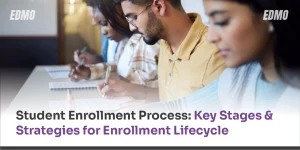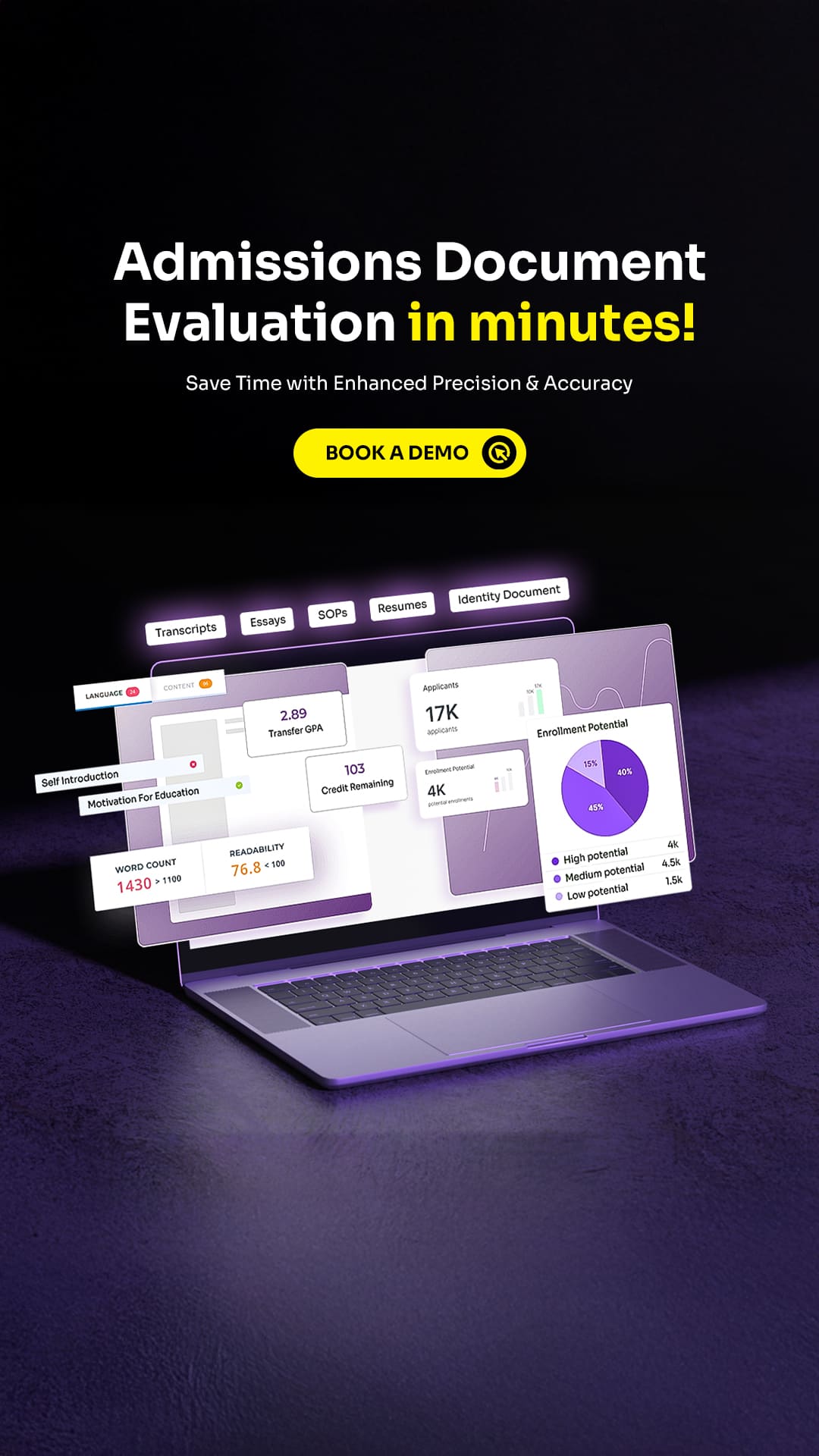The student enrollment process can sometimes be unnecessarily convoluted for universities and colleges. These 9 methods will help institutions simplify enrollment, and drive valuable leads for student acquisition.
Table Of Contents
Hitting the target for enrollment can be pretty tricky for the admissions team. With numerous technological advancements and tech-savvy students, the enrollment ratio might be on the rise. But at the same time, employing and testing new methods for enhancing the enrollment numbers is equally important. A few survey results and statistics are available to show us a clearer picture of how enrollment methods work in different universities and colleges. Here’s a closer look at the numbers and trends:
- Overall Enrollment Decline in the U.S.:
- Freshman enrollment dropped by 5% in fall 2024 (National Student Clearinghouse Research Center).
- Public and private nonprofit four-year institutions experienced a decline of over 6%.
- Private colleges serving many Pell Grant recipients saw an average drop of more than 10%.
- Indian Student Enrollment Decline:
- Indian graduate enrollment in the U.S. fell by nearly 26% in fall 2024 (SEVIS data).
- Indian students account for:
- 40% of all U.S. international graduate students.
- 60% of Indian students in the U.S. are studying at the graduate level.
- Institution-Specific Declines:
- Delta State University: Enrollment dropped by 2.3%, from 2,716 (fall 2023) to 2,654 (fall 2024).
- SUNY Buffalo State University: Total enrollment fell by 267 students, down to 6,138.
- Niagara University: Enrollment decreased by 193 students, reaching 3,994.
- International Student Enrollment in the UK:
- A 37% drop in international offers for UK postgraduate courses was reported in January 2024 compared to January 2023 (Enroly).
There are numerous strategies to increase the enrollment ratio of universities and colleges. Let’s dig into nine such techniques that can improve lead generation for universities and colleges.
9 ways to optimize student acquisition
1. Generate leads with digital ad campaigns
- Advertisements are considered one of the principal instruments in increasing the enrollment ratio. But, there are a few things that universities must ensure while using this tool.
- Lead nurturing now provides more customized content to leads as they progress through the funnel. It should not be confined to simply converting them into a sale.
- This may be accomplished by writing to position oneself as an authority on the subject or through social media marketing to retain engagement.
- The strength of digitalization is that it enables us to follow the behavior of our consumers. The data acquired may be further utilized to define the client’s demand and target them.
- Marketers may also use digital technologies to analyze their customers’ interactions, enabling them to better grasp their requirements and interests.
- Advertisements can be through Google search ads, Facebook ads, Instagram ads, etc. Finding the right source and using it carefully is the first stepping stone toward success.
- Here, having a landing page is quintessential. Simply put, landing pages are standalone web pages created for marketing or ad campaigns. A landing page serves many purposes, from giving details about the ad to redirecting users to the main website.
- Designed to instigate people to go for the call to action, the landing page should be easy to navigate, simple, and minimal.
- While the landing page consists of the request-for-information form, some people don’t complete these forms, and as a result, universities face the risk of losing their leads.
- But this problem can be solved by using the retargeting mechanism on the landing page itself. Here, ads or backlinks can be sent to their social media accounts to redirect them to the website.
2. Capture organic and direct website traffic
- Organic search results in web search engines are query results that are calculated algorithmically and are unaffected by advertisement payments. When a person comes directly to a website without first clicking on a link on another site, this is referred to as direct access (direct traffic).
- Making a website engaging yet simple is the first goal, but optimizing the website so that it appears in the organic search results is the second-most important point to be applied.
- To do this, universities first need to understand the requirements of students. For example, graduate students don’t want as much information on campus and student life as they do on degree requirements, course structure, etc.
- Therefore, apart from optimizing the landing page to generate leads, other important information should also be provided to help students understand what the university has to offer.
- This helps make the entire website more informative and increases organic reach.
3. Develop a content marketing strategy
- While lead generation is one of the most critical factors in university enrollment, content marketing too plays an essential role in building brand identity and awareness.
- Regular posts on various social media platforms or blogs on different courses offered by the university will increase the traffic to the website and generate more leads for the university.
- Thus, developing proper content marketing strategies becomes pivotal to improving any university’s website.
4. Improve conversations with responsive chatbots
- Almost 60% of the students filling out university forms expect to receive a response from the academic department on the very same day.
- Yet another survey by Drift says that colleges tend to lose their prospective students if they don’t follow up immediately.
- Though it is difficult to follow up immediately, universities can install chatbots to answer students’ queries promptly.
- If the doubts are too complicated, the query can be transferred to a human agent who can respond adequately.
5. Leverage high-profile endorsements
- Endorsing high-profile alumni in blogs, vlogs, social-media handles, advertisements, and other platforms can help the students trust the university’s credibility.
- Several studies have also shown that prospective students can easily trust the academy’s credibility if they are shown alumni employment track record.
- Following are some ways through which one can leverage high profile endorsements-
- Influencers who are technical subject matter experts: Influencers are clever, skilled domain experts who consistently remark on industry developments and technical difficulties with their distinct points of view for organizations targeting technical audiences. One should collaborate with these commentators, who are frequently linked with industry organizations or media. Another alternative is to develop one’s own influencer among the institution’s ranks.
- Cause-related influencer marketing efforts: Making a connection between influencer marketing activities and a cause can be an effective step. For example, Microsoft’s #MakeWhatsNext campaign encourages young females to explore STEM fields. On International Women’s Day, the company collaborated with National Geographic to display photographs of female scientists, receiving millions of likes and sparking tremendous conversation.
- Developing employee influencers: Training someone who works at the university and turning them into an influencer is an extremely creative form of influencer marketing. For example, a cosmetic company opted to exhibit its employees utilizing the merchandise instead of paying someone from outside. The firm already has an in-house influencer on staff as they grow their following. Even better, this process can be repeated.
6. Showcase campus life through Social Media Marketing
- Social media platforms are one of the best ways to advertise a university or a college. Several survey reports prove social media to be one of the best advertising platforms-
- As of 2024, there are approximately 5.16 billion active social media users worldwide, making up about 59.3% of the global population. This vast user base presents a huge opportunity for colleges to connect with potential students
- Facebook remains the largest social media platform, boasting over 3.15 billion monthly active users, while YouTube ranks second with over 2.5 billion active users. Instagram, with more than 2 billion active users, is the fourth-largest platform, making it a prime choice for showcasing campus life.
- Top institutions like Stanford University and Texas A&M University have already embraced the power of social media by showcasing their campus life, events, and academic culture on Instagram, engaging directly with students and building a vibrant online community.
7. Make use of live streaming and video chats
- It is easier for audiences to engage with audio-visual sources than with print mediums.
- One of the best features of almost all social media platforms is live streaming.
- Universities can live-stream classes, Q&A sessions, events, and other activities to improve engagement with the students.
8. Increase brand awareness using display advertising
- Displaying ads through digital mediums is much more effective than putting them on billboards or newspapers.
- Banner ads can be placed on high-traffic websites through the Google Display Network and presented in various engaging formats, including GIFs, photographs, videos, infographics, etc.
9. Communicate with email marketing
- Email remains a key marketing channel with 4.48 billion email users worldwide, and this number is projected to grow to 4.59 billion in 2025 and 4.73 billion by 2026. The vast reach makes email an essential platform for universities aiming to connect with potential students on a global scale.
- Email marketing has an average conversion rate of 3%, which highlights its effectiveness in driving actions, such as sign-ups, inquiries, or applications. Universities can improve their conversion rate by optimizing email content and using compelling calls to action.
What’s next?
- The call to move from the traditional enrollment mechanism to modern and technologically-equipped enrollment is the need of the hour.
- While several strategies can be implemented, the above ten strategies are core to every enrollment process.
- EDMO can help universities identify loopholes in their enrollment process and develop ways to boost the enrollment ratio.










No comments yet. Be the first to comment!
Leave a Comment